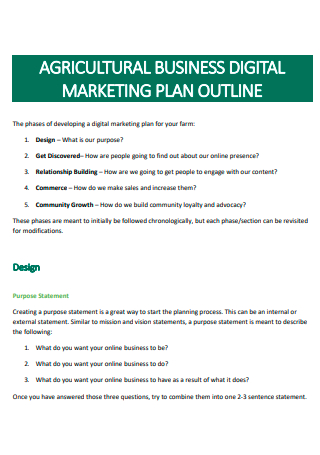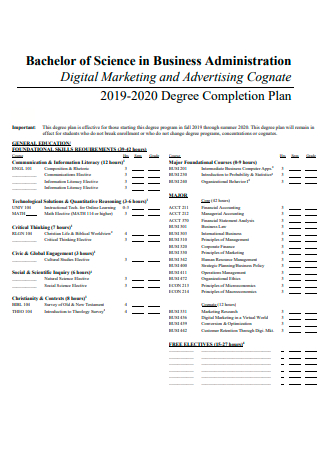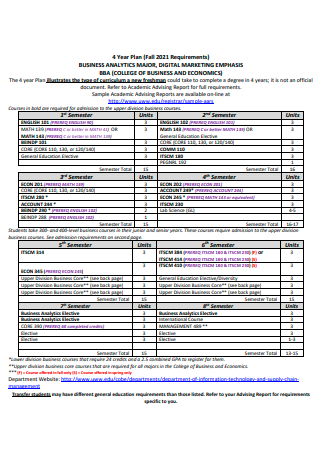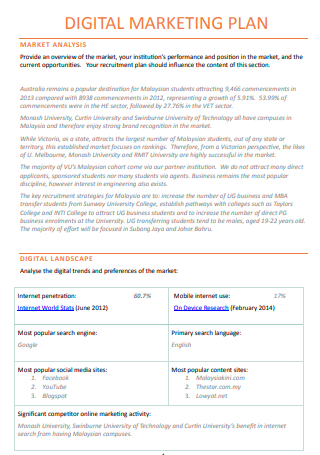3+ Sample Digital Marketing Business Plan
FREE Digital Marketing Business Plan s to Download
What Is a Digital Marketing Business Plan?
A digital marketing Business Plan outlines what you intend to achieve in a specific time frame in order to reach a set of company goals. When developing a digital marketing strategy, keep in mind that marketing is still about conveying the advantages of your product or service to customers in a way that they understand. As a result, the marketing methods that will assist your organization to engage your target audience with a consistent experience should be the emphasis of your strategy. If you need references, check out the available digital marketing business plan sample found in this article.
Digital Marketing Benefits over Traditional Marketing
Before proceeding to the steps in guiding you on how to write your own digital marketing business plan, you should also be aware of the benefits to preferring Digital marketing over traditional marketing. Keep reading and keep in mind the information curated in this list to comprehend better how to write a digital marketing agency business plan.
Low value: One of the most significant financial burdens that businesses must carry is the expense of marketing and advertising. While large corporations may have no issue spending millions on marketing and advertising, small businesses may find this impossible or an agonizing nightmare. Marketing via digital media is a more cost-effective option than traditional methods. They have the same impact yet cost a fraction of the price. You may sign up for an email marketing service for a few dollars and send transactional or direct Emails to thousands of consumers on your mailing list.Massic return on investment: Nothing is more important to a company than the return on its investment. Small expenditures in digital marketing provide a large return. When compared to traditional marketing tactics, email marketing and executing advertising campaigns on social media sites are inexpensive.Measurement is simple: A digital campaign’s success or failure may be simply determined. Unlike traditional approaches, which need weeks or months to assess the validity of a campaign, a digital campaign allows you to know how an ad is functioning nearly instantly. Users may track the performance of their emails using email marketing software; they can see how many were delivered, how many were read, and what their conversion rates are. Google Analytics is a powerful tool for determining how well a website or blog is performing.Quick to adjust: Knowing how well an advertisement performs will help a company decide how to continue. With only one click, you may increase the investment in a successful marketing campaign. However, if an advertisement is not performing as planned, it may easily be modified or stopped. Traditional marketing is more rigorous since a mountain of paperwork must be completed, and these agreements are usually for a long or medium period of time. Subscribers will have to wait until the end of the agreed-upon term even if a campaign does not perform as expected.Developing a brand: Businesses may improve their Brand and image by utilizing their digital channels. A well-designed website, a blog with high-quality and informative posts, and a highly involved social media channel are all examples of how a company may promote its brand. Shareable: Most digital marketing platforms have sharing features that allow campaigns and content to be shared with a large number of people. This has the potential to greatly boost sales outcomes by creating a multiplier effect.Targeting with precision: Traditional marketing employs the spray-and-pray strategy, in which an ad is broadcast across a large platform in the hopes that a few individuals who like what they see, hear, or read would respond positively. On the other side, digital marketing allows for targeted campaigning, where clients are shown adverts depending on their choices or first action. Consider transactional emails, order confirmation emails, receipts, and password reset emails, which are only sent to consumers in response to their actions toward the company. To put it another way, clients only receive what they ask for.Global: They claim that the world has become a global community. This has been made feasible because of technological advancements. Ad campaigns may be seen in any region of the world thanks to digital marketing. This provides modest start-ups with a once-in-a-lifetime opportunity to go worldwide because of the extensive exposure offered. There are several examples on the internet of start-ups that became enormously successful in a short period of time as a result of the potential afforded by the global nature of marketing via digital platforms.Segmentation: Not only can digital platforms be used to target advertising at specific customers, but they can also be used to segment customers. Segmentation is the process of breaking down huge customer groups into smaller groups of consumers based on a certain classification. Segmentation enhances the likelihood of sales while also lowering costs.Increased participation: The cyber-world is becoming increasingly noisy, and every product or service that your company provides is likely to be supplied by thousands of other companies. The average bounce rate on websites has grown, while users’ attention spans are decreasing. When visitors to a website can’t find what they are looking for right away, they depart for another site. Businesses may use these platforms to address consumer concerns, clear up misconceptions, and even create purchases. This may be accomplished through publishing informative blog entries, newsletters, shows, promotions, and special deals on a regular basis.
How to Make a Digital Marketing Business Plan
The most successful tactics for reaching valuable leads interested in your company are found in digital marketing. Now is the time to build a digital marketing business strategy if you don’t already have one. This article will show you how to make a digital marketing business plan through a curated list that will aid your digital marketing agency plan. If you are in need of references, check out an example of digital marketing business plan readily available for you.
Step 1: Establish your brand
Defining your brand is the first step in achieving success with your digital marketing strategy. It’s critical to understand the ins and outs of your brand in order to sell it to your target market. Define what makes your company stand out. What unique value do you bring to the table that your rivals lack? It’s crucial to know what makes your company special so you can advertise it to your target market. These are facts about your firm that are not only unique to it but also persuade someone to join your team. Start with establishing your company’s brand and determining what makes it special if you want to succeed with your digital marketing business strategy.
Step 2: Create buyer personas
Without understanding who you’re attempting to target, you can’t design a successful digital marketing strategy. The next phase in your digital marketing strategy is to define your target demographic by establishing buyer personas. Buyer personas are fictitious characters who embody the characteristics of the individuals you want to sell your products or services to. They represent your ideal consumer and the type of person who is most likely to buy from you. To construct your buyer persona, gather Data such as location, age, income, job title, hobbies and interests, and goals.
Step 3: Decide on your goals
Setting goals is essential for determining whether your marketing effort is beneficial in assisting your company’s growth. When setting goals, make sure to include both modest and large objectives. Small goals should help you stay on track to meet your larger objectives. It’s critical to have quantifiable goals while setting goals. These are also referred to as SMART Goals. You should develop goals that specify what you intend to accomplish. You will put your digital marketing company strategy on the fast road to success if you set targets.
Step 4: Select your digital marketing strategies
Choose the correct digital marketing tactics if you want to learn how to construct an efficient digital marketing plan. You know who you’re attempting to reach and what your objectives are, so the next step is to figure out how to get there. Search engine optimization, pay-per-click advertising, content marketing, email marketing, social media marketing, and influencer marketing are just a few of the options accessible to your company to reach these prospects. These are just a handful of the ways you may reach out to your target audience. When you’re creating your digital marketing strategy, you will need to decide which means you’ll employ to reach out to your target audience.
Step 5: Make a financial plan
Your campaign’s budget is quite important. Before you begin executing your tactics, you must first determine how much money you have to spend on your digital marketing strategy. With a marketing budget in place, you can better allocate your funds to the services you require. You may break down a budget and assign funds to multiple channels once you have established one. You will need to strike a balance between how much you are willing to spend on each channel and how much you will need to invest to get meaningful results.
Step 6: Analyze the results
A method for measuring results should always be included in a digital marketing campaign. Measuring results is critical for evaluating whether or not your efforts were effective. It’s critical to keep track of your outcomes to ensure you’re running the finest campaign possible. You may utilize key performance indicators to gauge the effectiveness of your campaign. These are figures that assist you to determine if you met your objectives. If you aren’t fulfilling your objectives, you have the option to reorganize your campaigns in order to get better outcomes. You may tweak and improve your techniques to better reach out to customers.
Components of a Digital Marketing Business Plan
Now that you are well aware of the steps to writing a digital marketing business plan, you should also be knowledgeable about what goes into the plan. They may not all be necessarily present in your plan, since you can go over one if it is not appropriate for your client or company. Nevertheless, go over the list to get an idea.
Advertising: Bidding and purchasing relevant ad units on third-party sites, such as display advertisements on blogs, forums, and other relevant websites, are examples of online advertising. Images, text, pop-ups, banners, and videos are examples of ad types. Retargeting is a crucial part of web marketing. To monitor new visitors to your site, retargeting requires code that inserts an anonymous browser cookie. You may then show advertising for your product or service to that person while they visit other websites. This concentrates your marketing efforts on those who have previously expressed an interest in your business.Marketing with content: The use of content marketing to attract new clients is an essential tactic. It will be easier to create thought leadership if you provide high-quality, relevant information on a regular basis on the internet. It may both educate and increase SEO rankings by informing target buyers about the challenges your product can help them address. Blog articles, case studies, whitepapers, and other items that give value to your target audience are examples of content. These digital content assets may subsequently be leveraged to gain customers organically and through sponsored initiatives.Marketing via email: Email marketing is a type of direct marketing in which promotional communications are sent to a selected set of prospects or consumers. Email marketing is still a good way to offer targeted communications to clients based on their requirements and interests. It is most commonly used by e-commerce companies to stay top of mind with their customers.Mobile advertising: The advertising of products or services using mobile phones and gadgets is known as mobile marketing. This covers text-message advertising as well as advertising in downloaded apps. A complete mobile marketing strategy, on the other hand, involves optimizing websites, landing pages, emails, and content for mobile devices.Paid search: Paid search boosts search engine exposure by allowing businesses to bid on specific keywords and buy ad space in the search engine results. Users who are actively looking for the keywords you have chosen will see your ads. Pay per click and cost per mille are the two most common methods of sponsored search advertising. You only pay for PPC when someone clicks on your ad. You pay based on the number of impressions using CPM.Programmatic advertising: Programmatic advertising is a method of bidding for digital ads that are automated. Profile data is utilized to auction the ad impression to rival marketers each time someone visits a website. Programmatic advertising gives you more control over which sites your ads appear on and who sees them, allowing you to better target your campaigns.Marketing on social media: Digital marketing includes Social Media marketing as a significant component. Paid possibilities to contact and communicate with potential consumers are available on platforms like Facebook, Twitter, Pinterest, Instagram, Tumblr, LinkedIn, and even YouTube. To reach a broader audience and boost brand lift, digital marketing initiatives frequently mix organic efforts with sponsored content and paid advertising promotions on important social media networks.Marketing through video: Companies may engage with customers in a more visually appealing and participatory way with Video marketing. You may use it to promote product launches, events, and special announcements, as well as instructive content and customer testimonials. The most popular video-sharing and advertising sites are YouTube and Vimeo. Pre-roll advertising is another option for digital marketers to reach out to video viewers.Webinars: Webinars are online meetings that allow businesses to communicate with new and existing clients from anywhere in the world. Webinars are an effective approach to provide relevant material to a focused audience in real-time, such as a product presentation or lecture. This type of direct engagement with your audience allows your firm to display deep subject matter expertise. To attract new leads and deepen current relationships, many organizations use attendance lists in other marketing activities.
FAQs
What is considered digital marketing?
Digital marketing, at its most basic level, is advertising distributed via digital channels like search engines, websites, social media, email, and mobile applications.
Can you do digital marketing from home?
The flexibility to work from home is arguably the most appealing aspect of a job in digital marketing. Because the majority of digital marketing chores can be accomplished online, many businesses and agencies allow their workers to work from home. SEO professionals are one of the more common work from home digital marketing jobs.
What are common marketing errors?
One of the most typical marketing blunders is failing to conduct research and testing. By forecasting how your goods and promotions will perform before you begin a single campaign, market research and evaluate how much you and your Company can save time and money.
As part of your company’s strategy, you have to think over the potential aids that will boost your marketing campaign. This is where a digital marketing business plan comes into the picture since it serves as a tool to boost your marketing efforts through digital tools. Since you have learned a sufficient amount of information, you are now more than ready to create a digital marketing business plan.




